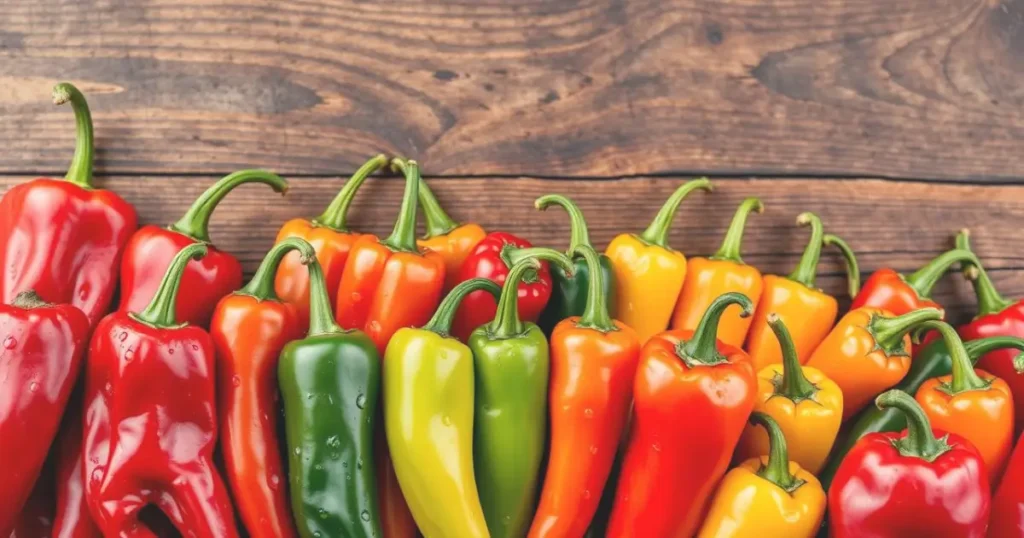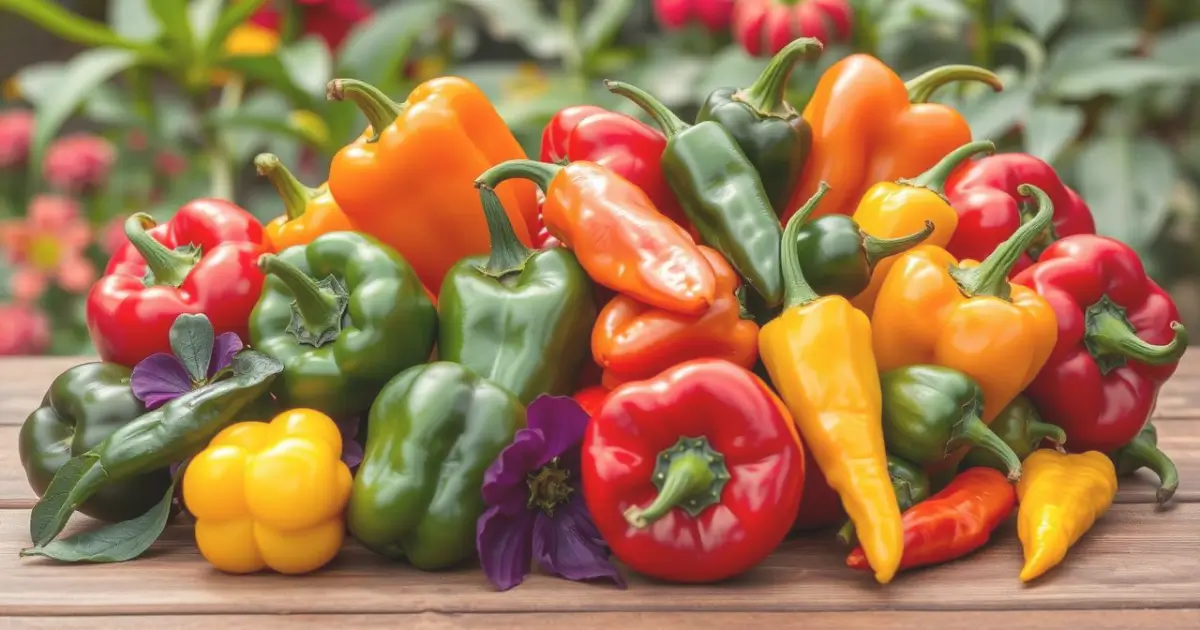Table of Contents
Ever pondered why certain dishes ignite your taste buds while others necessitate hydration? The explanation frequently hinges on the selection of chili pepper. This exhaustive guide will unveil the varied realm of spicy peppers, delving into the distinct types and their characteristic heat levels. Ranging from the mellow sweetness of bell peppers to the scorching ferocity of habaneros, each variety boasts its own narrative and taste profile.
Embark with us on an exploration of the profound history and cultural importance of these vibrant components, significantly broadening your comprehension of their potential to enhance your culinary explorations. Whether you are an avid home chef or simply a curious gastronome, grasping the distinctiveness of each chili pepper is crucial. Prepare to venture into the enthralling domain of spicy flavours!
Understanding Chilli Pepper Heat Levels
For those passionate about culinary arts or horticulture, grasping the heat levels of chilli peppers is paramount. This knowledge is deeply rooted in the Scoville scale, a metric that quantifies the spiciness of hot peppers. It does so by measuring the concentration of capsaicin, the compound that imparts their fiery essence.
What is the Scoville Scale?
Created by Wilbur Scoville in 1912, the Scoville scale measures the heat of peppers using a numerical value. to a pepper’s heat. This value, expressed in Scoville Heat Units (SHU), spans from 0 SHU for the mildest bell peppers to over 2 million SHU for the most scorching Carolina Reaper. Mastery of the Scoville scale empowers you to select peppers that harmonize with your culinary creations.
How to Measure Pepper Heat
Several methods exist to quantify pepper heat. Taste tests offer a tactile experience, allowing you to adjust recipes to suit your taste. Conversely, modern laboratory techniques provide precise measurements, shedding light on the true intensity of chili peppers. This scientific insight ensures the selection of the ideal pepper for any dish.
Different Types of Chilli Peppers
The realm of chili peppers is vast, offering a spectrum of flavors and heat levels, catering to diverse palates. Exploring popular chili pepper varieties reveals a myriad of culinary possibilities. Notably, jalapeños, serrano, habaneros, and ghost peppers emerge as distinct entities, each boasting a unique chili pepper profile that resonates with specific tastes. Grasping these nuances can profoundly enrich your culinary endeavors.
Popular Varieties and Their Profiles

A concise overview of the most celebrated chili pepper varieties, encompassing their heat intensities and flavor nuances, is presented below:
| Pepper Variety | Heat Level (Scoville) | Flavor Profile |
| Jalapeño | 2,500 – 8,000 | Fresh, slightly grassy |
| Serrano | 2,500 – 5,000 | Crisp, bright |
| Habanero | 100,000 – 350,000 | Fruity, floral |
| Ghost Pepper | 800,000 – 1,000,000 | Smoky, intense |
Regional Differences in Pepper Varieties
Geographical factors significantly shape the availability and cultivation of various peppers, leading to regional specialties. For instance, the American Southwest is renowned for Anaheim and Hatch peppers, celebrated for their mild heat and adaptability in diverse dishes. Conversely, the bird’s eye pepper, prevalent in Southeast Asian cuisine, offers a robust flavor and intense heat. Familiarity with these regional differences in peppers empowers you to make informed choices, ensuring the perfect pepper for your culinary projects.
Growing Chilli Peppers at Home
The cultivation of chilli peppers within domestic environments can be a profoundly rewarding pursuit. To ensure success, it is imperative to grasp the fundamental principles of cultivation. Begin by selecting a cultivar that excels in your local climatic conditions, ensuring it receives ample sunlight. The soil must be well-drained to foster optimal growth and robust root development. Consistent watering and judicious fertilization are paramount, as they significantly influence the productivity of your plants.
Best Practices for Cultivation
Adopting the following best practices is crucial when cultivating chilli peppers:
- Choose the right variety based on your climate.
- Provide at least six hours of sunlight daily.
- Use well-drained, nutrient-rich soil.
- Water consistently, avoiding over-saturation.
- Fertilize throughout the growing season to promote healthy and strong growth.
Common Pests and How to Manage Them
During the cultivation of chilli peppers, several common pests may emerge. Effective management is essential to safeguard your harvest:
- Aphids: Small, sap-sucking insects that can weaken plants. Use insecticidal soap to ease the infestation.
- Spider mites: These pests thrive in dry conditions. Increase humidity around your plants or use miticides if the problem escalates.
- Whiteflies: They can rapidly reproduce and damage leaves. Introducing beneficial insects like ladybugs can help keep whitefly populations in check.
Cooking with Chilli Peppers
Chilli peppers can transform your culinary creations, adding both flavor and heat to various dishes. Understanding how to incorporate these vibrant ingredients is crucial for any home cook aiming to elevate their meals. The best chilli pepper recipes often showcase the unique characteristics of different peppers, allowing you to explore diverse flavor profiles.
Incorporating Peppers into Your Dishes
When cooking with chilli peppers, it’s essential to choose the right type for your dish. For instance:
- Jalapeños: Ideal for fresh salsas and tacos.
- Habaneros: Great for marinating meats and adding heat to sauces.
- Bell Peppers: Best for salads and stir-fries, offering sweetness without the heat.
Consider blending different types to create depth in your dishes. The versatility of chilli peppers makes them suitable for various cuisines, from Thai to Mexican.
Tips for Balancing Heat in Recipes
Balancing heat in dishes allows you to enjoy the flavor without being overwhelmed. Here are some effective strategies:
- Pair spicy peppers with dairy products like yogurt or cheese to mellow the heat.
- Add citrus elements such as lime or lemon juice to brighten flavors.
- Incorporate sweeteners like honey or sugar to counteract the spice.
By integrating these methods, you can create harmonious flavor profiles that enhance your cooking experience. Experimenting with various ingredients will lead to discovering your favorite combinations in cooking with chilli peppers.
Health Benefits of Chilli Peppers
Chilli peppers transcend their role as a mere culinary spice, embodying a wealth of nutrients and health advantages. The nutritional profile of chilli peppers is marked by an abundance of vitamins A and C, alongside a plethora of antioxidants and capsaicin. This synergy of elements is instrumental in bolstering overall health, positioning chilli peppers as a quintessential dietary component.
Nutrition Facts of Chilli Peppers
The integration of chilli peppers into one’s diet can yield a multitude of nutritional benefits. The following table delineates some of the most significant nutritional facts:
| Nutrient | Amount per 100g |
| Calories | 40 |
| Vitamin A | 187% DV |
| Vitamin C | 144% DV |
| Capsaicin | 0.2-1.0% |
| Fiber | 1.5g |
The inclusion of chilli peppers in one’s diet may contribute to pain alleviation, metabolic enhancement, and cardiovascular health optimization. Their antioxidant properties are believed to combat inflammation and diminish the likelihood of chronic disease development.
Potential Health Risks to Consider
Despite their myriad health benefits, it is crucial to acknowledge the potential risks associated with consuming spicy peppers. Excessive consumption can precipitate gastrointestinal distress, encompassing heartburn and stomach irritation. Variability in individual tolerance necessitates a cautious approach to consumption, advocating for moderation.
Conclusion
The realm of chilli pepper varieties is a vast expanse, teeming with an array of flavors and health benefits. Understanding the Scoville Scale allows you to navigate the complexities of heat levels, enabling a deeper appreciation for the distinct characteristics of each pepper. This knowledge empowers you to enhance your culinary endeavors, enriching your gastronomic experiences with the unique taste and heat of each variety.
Armed with insights into growing, cooking with spicy peppers, and their health benefits, you are poised to integrate these vibrant ingredients into your diet. Their inclusion can significantly boost both the flavor and nutritional content of your meals. By embracing the diverse advantages of chilli peppers, you can transform your dining experiences into a more flavorful and health-conscious journey.
Through experimentation with various chilli pepper varieties, you can master the art of balancing heat and flavor in your culinary creations. Allow your taste buds to embark on a journey of discovery, transforming everyday meals into exquisite culinary experiences. As you delve into the world of chilli peppers, each dish becomes a new chapter in the exploration of taste and well-being.
FAQ
What are the different types of chilli peppers?
The realm of chilli peppers encompasses a vast array of varieties, each distinguished by its unique flavor profile and heat intensity. Notable among these are the jalapeño, habanero, serrano, and ghost peppers. For those seeking to expand their culinary horizons, less common options such as shishito, Anaheim, and Thai bird’s eye peppers offer a diverse range of flavors.
How can I measure the heat of chilli peppers?
The Scoville Scale serves as the benchmark for quantifying the heat of chilli peppers. This scale, which ranges from the mildness of bell peppers at 0 SHU to the fiery intensity of peppers like the Carolina Reaper, which can exceed 2 million SHU, is based on the concentration of capsaicin, the compound responsible for the sensation of heat.
What are the health benefits of consuming chilli peppers?
Chilli peppers are a treasure trove of nutrients, boasting high levels of vitamins A and C, as well as antioxidants and capsaicin. These components may contribute to enhanced metabolism, reduced appetite, and pain relief. However, it is crucial to consume them in moderation to avoid gastrointestinal distress.
How do I grow chilli peppers at home?
Successful cultivation of chilli peppers at home necessitates the selection of a variety that is compatible with your local climate. Ensure that they receive sufficient sunlight and are planted in well-drained soil. Regular watering and fertilization are paramount. Vigilance against pests such as aphids and spider mites is essential, with natural pest control methods like beneficial insects or insecticidal soap being effective alternatives to chemical treatments.
What are some best chilli pepper recipes to try?
The versatility of chilli peppers lends itself to a multitude of culinary creations. Consider crafting a fresh salsa with jalapeños, a spicy guacamole with serranos, or a hot pepper sauce with habaneros. These peppers can also be incorporated into stews, marinades, or stir-fries to elevate both flavor and heat levels.
How do I balance heat when cooking with chilli peppers?
Achieving a harmonious balance of heat in your dishes can be accomplished by pairing spicy peppers with milder ingredients. For instance, the addition of sour cream or yogurt can effectively counteract the heat of spicier peppers, thereby enhancing the overall flavor without overwhelming the palate.
Are there any potential health risks associated with eating spicy peppers?
While chili peppers offer numerous health benefits, excessive consumption can lead to gastrointestinal discomfort, including heartburn or an upset stomach. It is imperative to consider individual tolerance levels when introducing spicy peppers into your diet. Begin with small amounts if you are uncertain about your sensitivity to avoid adverse reactions.

